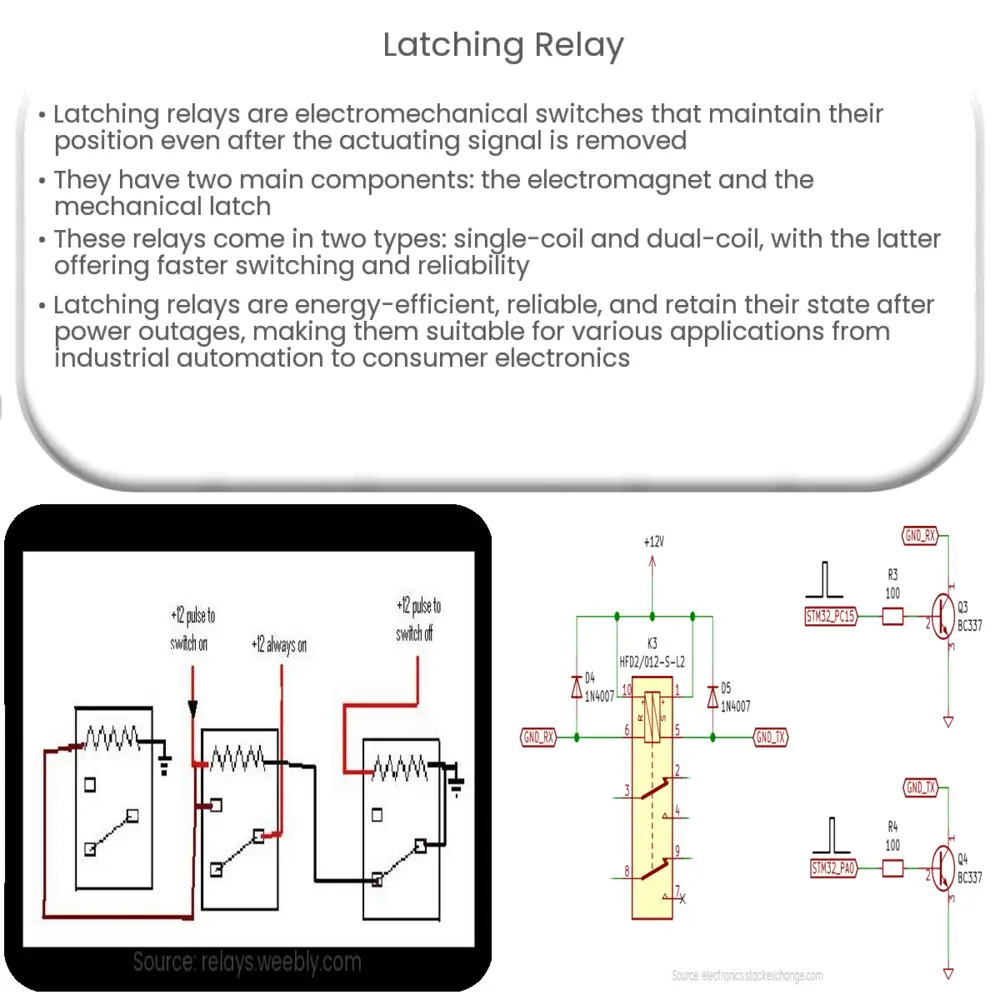A latching relay is an energy-efficient, electromechanical switch that maintains its state after the actuating signal is removed, ideal for various applications.

Latching Relay: An Introduction
Overview
A latching relay is a type of electromechanical switch that maintains its state even after the actuating signal has been removed. These relays are designed to toggle between two stable positions – open and closed – and remain in the last position until they receive another signal. Latching relays are commonly used in a wide range of applications, from industrial control systems to consumer electronics.
How Latching Relays Work
Latching relays consist of two main components: the electromagnet and the mechanical latch. The electromagnet is responsible for generating a magnetic field when an electrical current is applied, while the mechanical latch holds the relay’s contacts in position. When a control signal is sent to the relay, it energizes the electromagnet, creating a magnetic field that either pulls the contacts together (closing the circuit) or pushes them apart (opening the circuit). The mechanical latch ensures that the contacts remain in their new position even after the control signal is removed.
There are two main types of latching relays: single-coil and dual-coil. Single-coil latching relays use one coil to control both the open and closed positions of the relay. A change in polarity of the control signal determines whether the relay will open or close. Dual-coil latching relays, on the other hand, use two separate coils to control the open and closed positions. Energizing one coil will open the relay, while energizing the other will close it. Dual-coil latching relays typically offer faster switching speeds and greater reliability compared to single-coil designs.
Advantages of Latching Relays
Latching relays offer several advantages over standard non-latching relays. Some of the key benefits include:
- Energy efficiency: Since latching relays maintain their position without the need for continuous power, they consume significantly less energy compared to non-latching relays. This makes them ideal for battery-powered devices and energy-saving applications.
- Reliability: Latching relays are less prone to mechanical wear and tear as their contacts do not continuously open and close. This results in a longer operational lifespan and reduced maintenance requirements.
- Memory function: The ability to maintain their state even after a power outage makes latching relays suitable for applications that require a memory function, such as alarm systems or lighting control.
Applications of Latching Relays
Due to their unique characteristics, latching relays are used in a variety of industries and applications. Some common examples include:
- Industrial automation systems
- Consumer electronics, such as televisions and audio equipment
- Smart home and building automation
- Automotive systems, including power windows and door locks
- Energy management and load control
- Remote and manual control of lighting systems
Selecting the Right Latching Relay
When choosing a latching relay for a specific application, there are several factors to consider:
- Contact rating: The relay’s contact rating determines the maximum current and voltage it can handle. It is essential to choose a relay with a contact rating suitable for the application’s requirements to prevent premature failure or safety hazards.
- Switching time: Switching time refers to the time it takes for the relay contacts to change from one position to another. Depending on the application, a faster or slower switching time may be required.
- Coil voltage: The coil voltage specifies the voltage required to energize the relay’s electromagnet. This value should match the voltage of the control signal used in the application.
- Mounting options: Latching relays are available in various mounting options, including printed circuit board (PCB) mount, panel mount, and DIN rail mount. The choice will depend on the installation requirements and space constraints of the application.
Common Latching Relay Issues and Troubleshooting
While latching relays are generally reliable, they can still encounter problems or failures. Some common issues and their possible solutions include:
- Contacts sticking: Over time, the relay contacts may become dirty or oxidized, causing them to stick together and preventing proper operation. In such cases, cleaning the contacts with an appropriate contact cleaner can help restore functionality.
- Coil failure: The relay’s coil can fail due to overheating or overvoltage, resulting in the inability to change the contact position. Replacing the relay or using a relay with a higher coil rating can resolve this issue.
- Mechanical failure: The mechanical latch may wear out or become damaged, causing the relay to lose its latching capability. In this case, replacing the relay is typically the best solution.
Conclusion
Latching relays are versatile and energy-efficient electromechanical switches that find extensive use across various industries and applications. They offer numerous advantages, including reduced power consumption, improved reliability, and memory function. When selecting a latching relay, factors such as contact rating, switching time, coil voltage, and mounting options should be carefully considered. Regular maintenance and troubleshooting can help ensure the optimal performance and longevity of these devices. By understanding the fundamentals of latching relays, engineers and designers can effectively incorporate them into their projects, creating more efficient and reliable systems.




